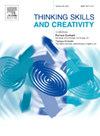教育中的心理想象:心理想象对初中生的视觉空间处理和学习成绩有何影响?
IF 3.7
2区 教育学
Q1 Social Sciences
引用次数: 0
摘要
本研究探讨了初中生心理想象、视觉空间处理和学习成绩之间的关系。研究还探讨了这些变量对意大利语、数学、美术和音乐学习成绩的影响。研究使用心理想象测验和瑞文渐进矩阵对初三学生进行了测试。对性别差异进行了探讨,结果显示,心理想象和视觉空间处理方面没有显著差异。心理想象力越高,学习成绩越好,尤其是意大利语和数学。视觉空间处理对心理想象与意大利语和数学学习成绩之间的关系起着中介作用,表明它在这些科目中起着重要作用。然而,这种中介作用在音乐和美术中并不显著,这表明有其他认知机制的参与。这些发现强调了心理想象和视觉空间处理对学业成功的重要性,尤其是在抽象学科中,并提倡针对这些认知领域的教育策略,以不仅提高学生的成绩,而且提高他们的创造力和思维能力。本文章由计算机程序翻译,如有差异,请以英文原文为准。
Mental imagery in education: What impact on the relationships with visuospatial processing and school performance in junior high school students?
This study examined the relationship between mental imagery, visuospatial processing, and academic performance among junior high school students. The influence of these variables on learning outcomes in Italian, mathematics, art, and music was also investigated. Third-year students were tested using the Mental Imagery Test and Raven's Progressive Matrices. Gender differences were explored, revealing no significant differences in mental imagery and visuospatial processing. Higher mental imagery correlated with better academic performance, particularly in Italian and mathematics. Visuospatial processing mediated the relationship between mental imagery and academic performance in Italian and mathematics, suggesting its significant role in these subjects. However, this mediation was not significant for music and art, suggesting the involvement of alternative cognitive mechanisms. These findings highlight the importance of mental imagery and visuospatial processing in academic success, particularly in abstract subjects, and advocate for educational strategies targeting these cognitive domains to enhance not only student performance but also creativity and thinking skills.
求助全文
通过发布文献求助,成功后即可免费获取论文全文。
去求助
来源期刊

Thinking Skills and Creativity
EDUCATION & EDUCATIONAL RESEARCH-
CiteScore
6.40
自引率
16.20%
发文量
172
审稿时长
76 days
期刊介绍:
Thinking Skills and Creativity is a new journal providing a peer-reviewed forum for communication and debate for the community of researchers interested in teaching for thinking and creativity. Papers may represent a variety of theoretical perspectives and methodological approaches and may relate to any age level in a diversity of settings: formal and informal, education and work-based.
 求助内容:
求助内容: 应助结果提醒方式:
应助结果提醒方式:


